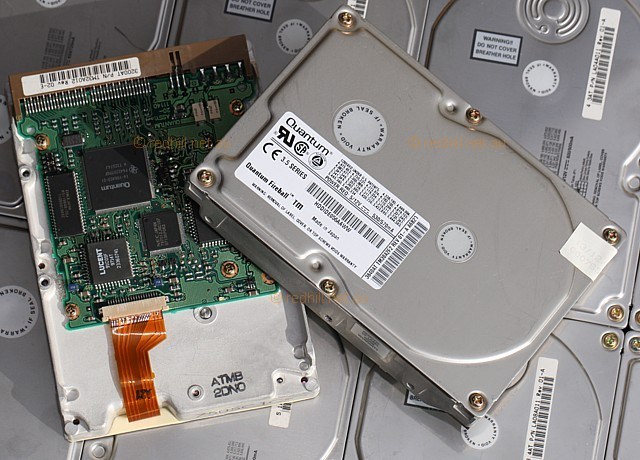
Photo: Red Hill.
Quantum Fireball TM
Quantum's original Fireball drives were very high performance drives indeed, matched only by Seagate's Decathlon range. For year after year the Fireball vs Decathlon contest raged, with both companies having a fair share of wins and losses.
Unfortunately, Quantum's marketing department got into the habit of using "Fireball" to describe all of Quantum 3.5 inch IDE drives, not just the high-performance models. This caused no end of confusion — and undoubtedly helped Quantum sell its slower 3.5 inch models to the unwary.
Although not especially honest, calling the TMs "Fireballs" made a sort of sense. But this was just the start: no marketing department was ever so deranged as Quantum's used to be. Amongst other exploits, Quantum touted the Atlas 10K II as "the fastest hard drive in the world" when it wouldn't actually exist as a shipping product for six months yet, and was in any case clearly inferior to the well-established Seagate Cheetah X15; and retrospectively decided that the Atlas IV had somehow been "designed for Intel's Itanium!" We never quite worked out if the Quantum marketing team was terminally dishonest or just extraordinarily ignorant. No matter: Quantum was eventually bought out by Maxtor, and Maxtor hired different PR guys. This was a pity in a way: in the good old days you could always rely on the Quantum PR team for an unexpected belly laugh.
Thankfully, there was nothing at all wrong with Quantum's design and engineering departments! Like most Quantum drives, the Fireball TMs were good products. They were relatively modest 4500 RPM units, but very high-tech in their day, and the high areal density and excellent seek performance made them almost as quick as many of the competing 5400 RPM drives.
The TM was our first new Quantum drive since 170MB days. We sold a moderate number of the the 2.5 and a handful of the 3.2GB models new, and saw many others traded in over the years that followed.
Notice the unusual odd number of heads in the 1.7 and the 3.2. This would become common in future years but had been quite a rarity until about this time.
| Performance | 0.95 | Reliability | AA2 |
| Data rate | 95 Mbit/sec | Spin rate | 4500 RPM |
| Seek time | 10.5ms | Buffer | 128k |
| Read channel | PRML | Head technology | MR |
| Platter capacity | 1.08GB | Interface | IDE mode 4 |
| 1080AT | 1.08GB | 2 head | |
| 2110AT | 2.1GB | 4 heads | |
| Platter capacity | 1.28GB | Interface | IDE mode 4 |
| 1280AT | 1.28GB | 2 heads | |
| 1700AT | 1.7GB | 3 heads | |
| 2550AT | 2.5GB | 4 heads | ** |
| 3200AT | 3.2GB | 5 heads | * |
| 3840AT | 3.8GB | 6 heads |